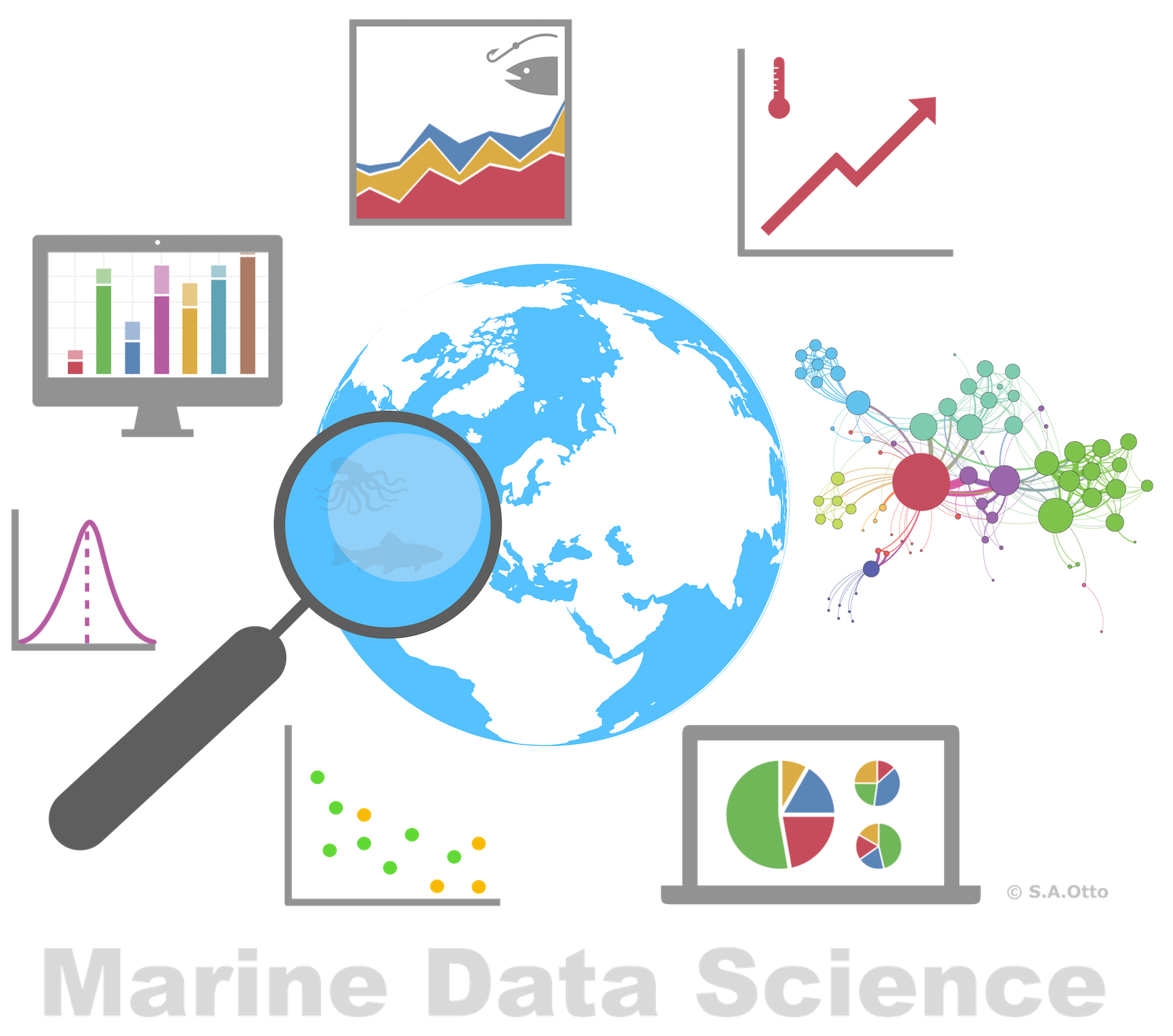


Data Analysis with R
15 - Modelling demonstration
Saskia A. Otto
Postdoctoral Researcher
A model building demonstration
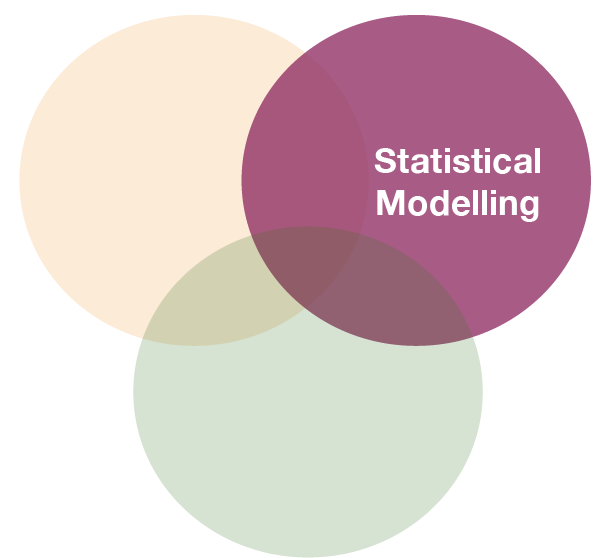
Demonstration with Plaice CPUE in the Baltic Sea
Research question:
What factors explain best the pattern in age-specific Catch-Per-Unit-Effort (CPUE) of Pleuronectes platessa (plaice) in the first quarter of 2015?
Since we have longitude, latitude, and age in our dataset we can test whether these variables have any effect. Lets start with longitude as it is commonly known that plaice is more frequent in the Western Baltic Sea.
Import and modify data
cpue <- read_csv("data/CPUE per age per area_2017-11-20 06_48_16.csv")
plaice <- cpue %>%
mutate(Area = factor(Area, levels = c(21,22,
23,24,25,26,27,28,29,30,31,32))) %>%
filter(Year == 2015, Quarter == 1, Species == "Pleuronectes platessa") %>%
select(Area, Quarter, Species, contains("Age")) %>%
gather(key = "Age", value = "CPUE", Age_0:Age_10) %>%
mutate(Age = factor(Age, levels = paste0("Age_", 0:10),
labels = c("0","1","2","3","4","5","6","7","8","9","10")))
sd_coord <- tibble(
Area = factor(c(21,22,23,24,25,26,27,28,29,30,31,32)),
Lat = c(57,55,55.75,55,55.5,55.5,58,57.5,59.5,62,64.75,60),
Long = c(11.5,11,12.5,13.5,16,19.5,18,20,21,19.5,22.5,26)
)
# Merge this table into the cpue data
plaice <- left_join(plaice, sd_coord, by = "Area")
Step 1: Specification of model family
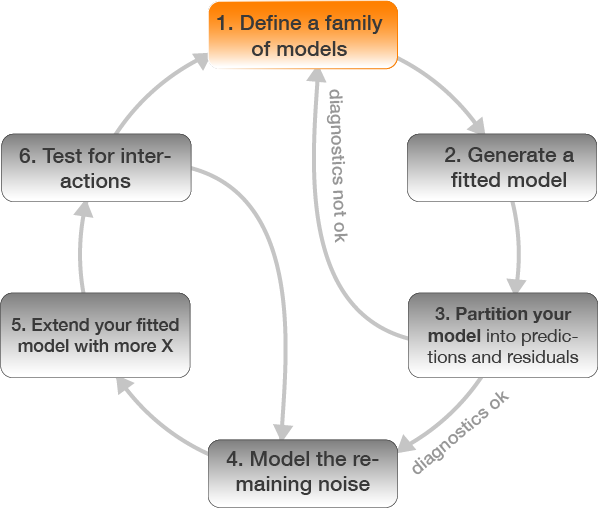

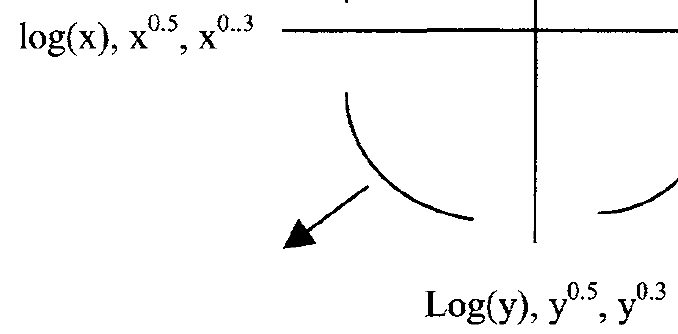
Since a straight line seems less appropriately we will compare different model families including polynomials and transformation of Y.
Step 2: Model fitting
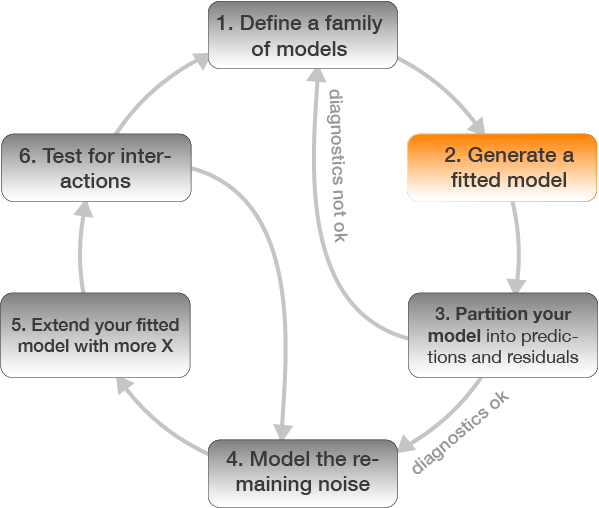
plaice <- plaice %>%
mutate(CPUE_log = log(CPUE + 0.001))
m_lm <- lm(CPUE ~ Long, data = plaice)
m_poly2 <- lm(CPUE ~ poly(Long,2), data = plaice)
m_poly3 <- lm(CPUE ~ poly(Long,3), data = plaice)
m_log_y <- lm(CPUE_log ~ Long, data = plaice)
Step 3: Model partitioning - predicted values → model fit
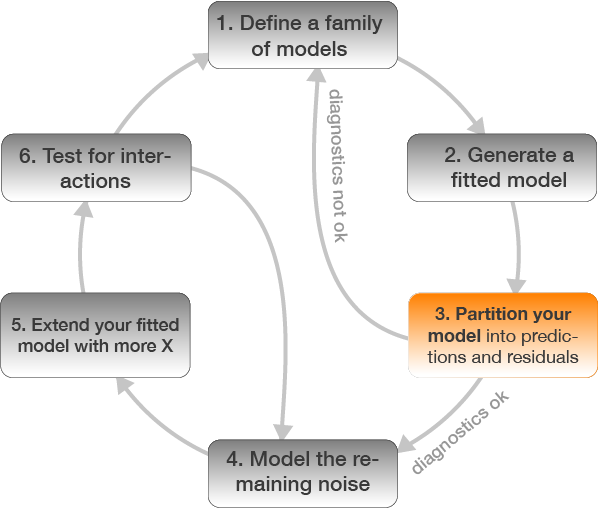

Which model do you prefer? Which models are misfitting the data? Which problem becomes more apparent when log-transforming CPUE?
- There are too many zeros in the CPUE data!
Step 3: Residuals → model assumptions


Zero-inflation
Too many zeros in the data can inflate the parameterization of coefficients.
- One can either apply specific models that account for it (e.g. zero-truncated or zero-inflated regression models),
- convert the data into binary data (presence/absence) and apply a logistic regression,
- or reduce the number of zeros by
- summing up the CPUE over all age classes (disadvantage: we reduce the sample size)
- or, in this demostration, by removing specific age classes
→ In any case, we need to rephrase our research question!
plaice %>% group_by(Age, CPUE) %>%
filter(CPUE < 0.01) %>%
summarize(counts = n()) %>% print(n=40)
## # A tibble: 8 x 3
## # Groups: Age [?]
## Age CPUE counts
## <fct> <dbl> <int>
## 1 0 0 5
## 2 1 0 3
## 3 5 0 1
## 4 6 0 2
## 5 7 0 3
## 6 8 0 2
## 7 9 0 3
## 8 10 0 4
Lets remove age 0, 1 and > 6 and start with step 2 again.
Reformulate research question:
What factors explain best the pattern in age-specific Catch-Per-Unit-Effort (CPUE) of Pleuronectes platessa (plaice) age 2- 6 in the first quarter of 2015?
Repeat step 2: Model fitting with new data

plaice <- plaice %>% filter(Age %in% 2:6) %>%
mutate(Age = fct_drop(Age))
m_lm <- lm(CPUE ~ Long, data = plaice)
m_poly2 <- lm(CPUE ~ poly(Long,2), data = plaice)
m_poly3 <- lm(CPUE ~ poly(Long,3), data = plaice)
m_log_y <- lm(CPUE_log ~ Long, data = plaice)
For reasons of convenience I named the subset also 'plaice' so I can simply run the previous code again without many modifications.
Repeat step 3: Model partitioning - predicted values


How do the models perform now?
Repeat step 3: Model partitioning - residuals


What next?
m_log_yshows the best residual distribution so we could focus on this model and move on the step 4; however, for some age classes this model greatly underestimates the CPUE.- The models with untransformed data do not look too bad either (particularly the polynomials) so we could keep them for now and see whether including more variables helps reducing the noise and improving the model fit.
Step 4: Model residuals ~ another X variable
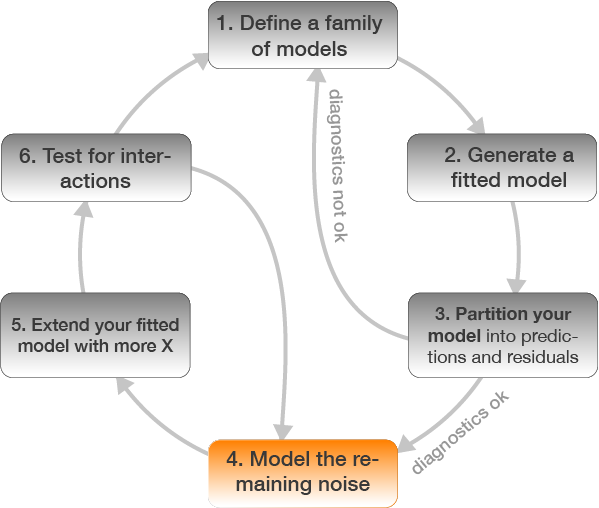

Step 4: Model residuals ~ another X variable


Step 5: Re-specify the model and visualize the predictions
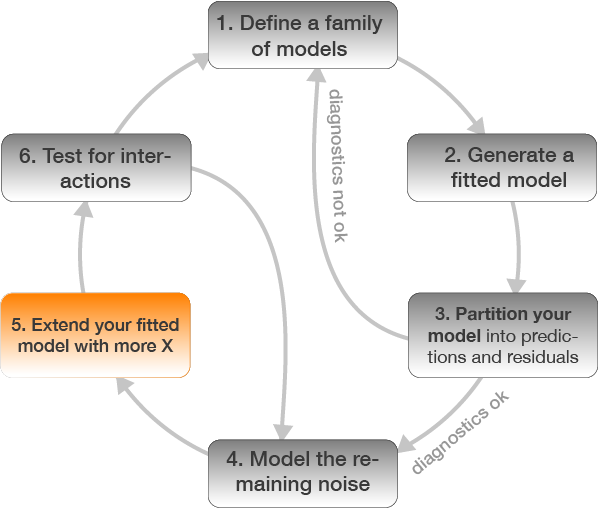
m_lm <- update(m_lm, .~. + Age)
m_poly2 <- update(m_poly2, .~. + Age)
m_poly3 <- update(m_poly3, .~. + Age)
m_log_y <- update(m_log_y, .~. + Age)

Happy now?

Step 6: Test for an interaction between Long and Age
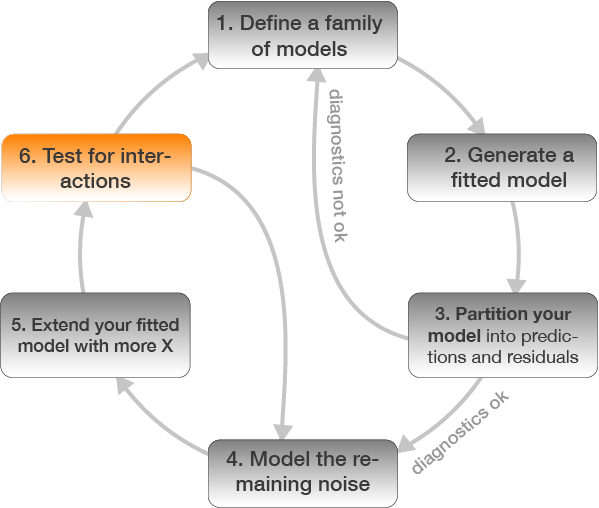
m_lm_int <- lm(CPUE ~ Long * Age, data = plaice)
m_poly2_int <- lm(CPUE ~ poly(Long,2) * Age, data = plaice)
m_poly3_int <- lm(CPUE ~ poly(Long,3) * Age, data = plaice)
m_log_y_int <- lm(CPUE_log ~ Long * Age, data = plaice)

Better?

Go back to step 4: Model residuals ~ latitude


No clear pattern that suggests to include latitude in the model (in the mod_log_y model it seems residuals decrease with latitude but that is mainly caused by the 2 outliers).
So which one to choose?
- From the residual diagnostics it seems that
mod_log_ywithAgeandLongis the best, but the cubic model is also quite good. - Should an interaction term be included or not? Difficult to say from the graphics.
- Lets use the AIC to guide our decision!
- It is wise to include a NULL model (with only an intercept) to see whether any of the covariate should be included or not.
- Recall: the AIC is only useful for comparison between models fitted to the same observations and same Y variables: you can't compare models fitted to different data subsets or if Y is partly transformed!
Overview of models we fitted
m0 <- lm(CPUE ~ 1, data = plaice)
m_lm_1 <- lm(CPUE ~ Long, data = plaice)
m_lm_2 <- lm(CPUE ~ Long + Age, data = plaice)
m_lm_3 <- lm(CPUE ~ Long * Age, data = plaice)
m_poly2_1 <- lm(CPUE ~ poly(Long,2), data = plaice)
m_poly2_2 <- lm(CPUE ~ poly(Long,2) + Age, data = plaice)
m_poly2_3 <- lm(CPUE ~ poly(Long,2) * Age, data = plaice)
m_poly3_1 <- lm(CPUE ~ poly(Long,3), data = plaice)
m_poly3_2 <- lm(CPUE ~ poly(Long,3) + Age, data = plaice)
m_poly3_3 <- lm(CPUE ~ poly(Long,3) * Age, data = plaice)
# Now the log-models
m_log_y_0 <-lm(CPUE_log ~ 1, data = plaice)
m_log_y_1 <-lm(CPUE_log ~ Long, data = plaice)
m_log_y_2 <-lm(CPUE_log ~ Long + Age, data = plaice)
m_log_y_3 <-lm(CPUE_log ~ Long * Age, data = plaice)
AIC(m0, m_lm_1, m_lm_2, m_lm_3, m_poly2_1, m_poly2_2, m_poly2_3,
m_poly3_1, m_poly3_2, m_poly3_3)
## df AIC
## m0 2 262.6016
## m_lm_1 3 256.8791
## m_lm_2 7 254.4298
## m_lm_3 11 252.9204
## m_poly2_1 4 257.0557
## m_poly2_2 8 253.6051
## m_poly2_3 16 252.1079
## m_poly3_1 5 258.3897
## m_poly3_2 9 254.5438
## m_poly3_3 21 255.0540
AIC(m_log_y_0, m_log_y_1, m_log_y_2, m_log_y_3)
## df AIC
## m_log_y_0 2 137.3974
## m_log_y_1 3 135.0501
## m_log_y_2 7 129.8373
## m_log_y_3 11 135.0000
Summary of final model: m_log_y_2

summary(m_log_y_2)
##
## Call:
## lm(formula = CPUE_log ~ Long + Age, data = plaice)
##
## Residuals:
## Min 1Q Median 3Q Max
## -7.7375 -0.6531 0.1546 1.4860 3.1414
##
## Coefficients:
## Estimate Std. Error t value Pr(>|t|)
## (Intercept) 8.5793 2.8565 3.003 0.00731 **
## Long -0.4436 0.1793 -2.474 0.02295 *
## Age3 1.1864 1.7805 0.666 0.51320
## Age4 0.0158 1.7805 0.009 0.99301
## Age5 -2.6477 1.7805 -1.487 0.15340
## Age6 -4.4044 1.7805 -2.474 0.02298 *
## ---
## Signif. codes: 0 '***' 0.001 '**' 0.01 '*' 0.05 '.' 0.1 ' ' 1
##
## Residual standard error: 2.815 on 19 degrees of freedom
## Multiple R-squared: 0.5046, Adjusted R-squared: 0.3742
## F-statistic: 3.871 on 5 and 19 DF, p-value: 0.01377
The R code for this demonstration can be found under 'Exercises'
Time for your SECOND case study!!!
Photo by NASA (ID ISS040-E-12110), accessed here
Thank You
For more information contact me: saskia.otto@uni-hamburg.de
http://www.researchgate.net/profile/Saskia_Otto
http://www.github.com/saskiaotto

This work is licensed under a
Creative Commons Attribution-ShareAlike 4.0 International License except for the
borrowed and mentioned with proper source: statements.
Image on title and end slide: Section of an infrared satallite image showing the Larsen C
ice shelf on the Antarctic
Peninsula - USGS/NASA Landsat:
A Crack of Light in the Polar Dark, Landsat 8 - TIRS, June 17, 2017
(under CC0 license)